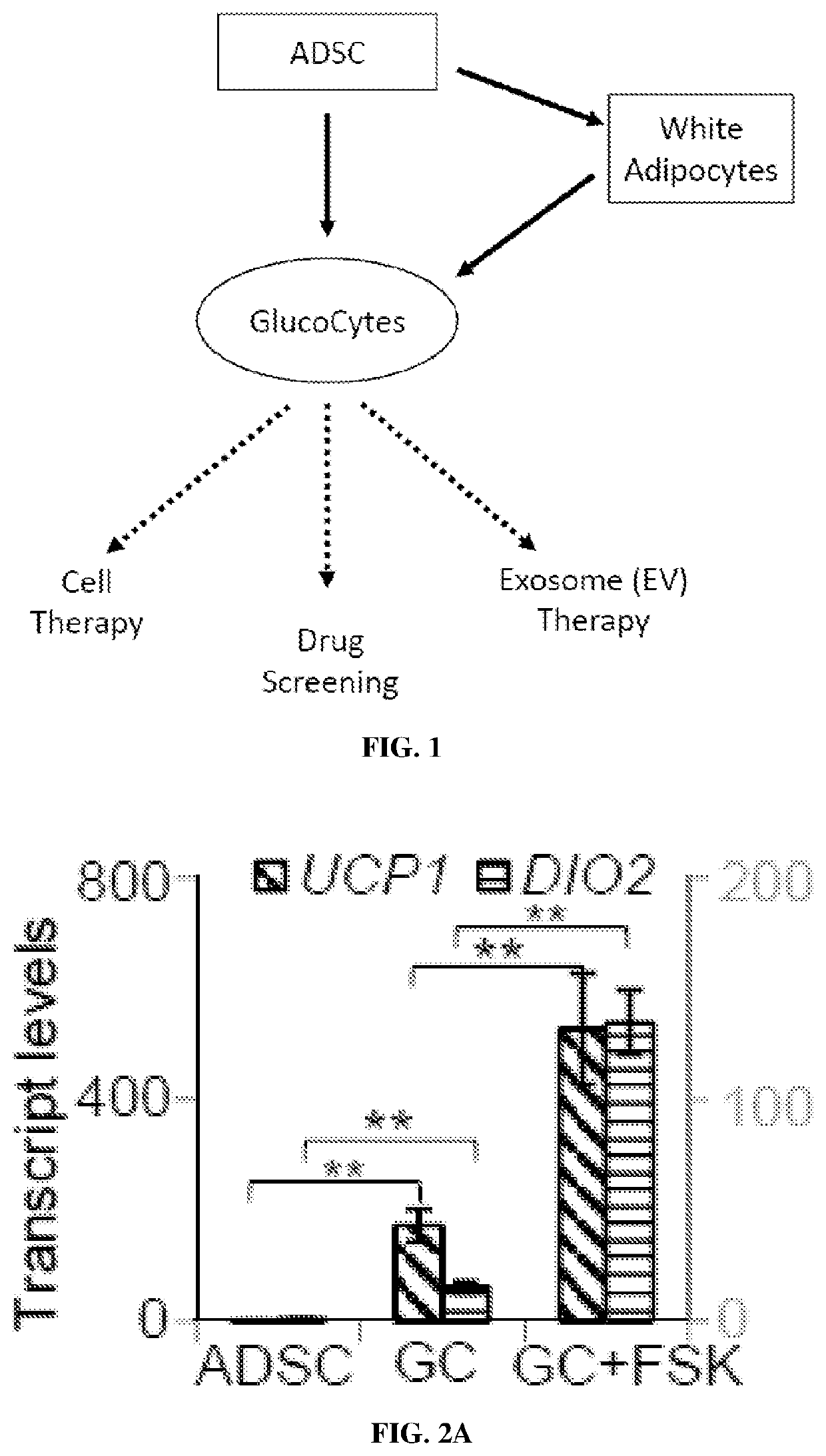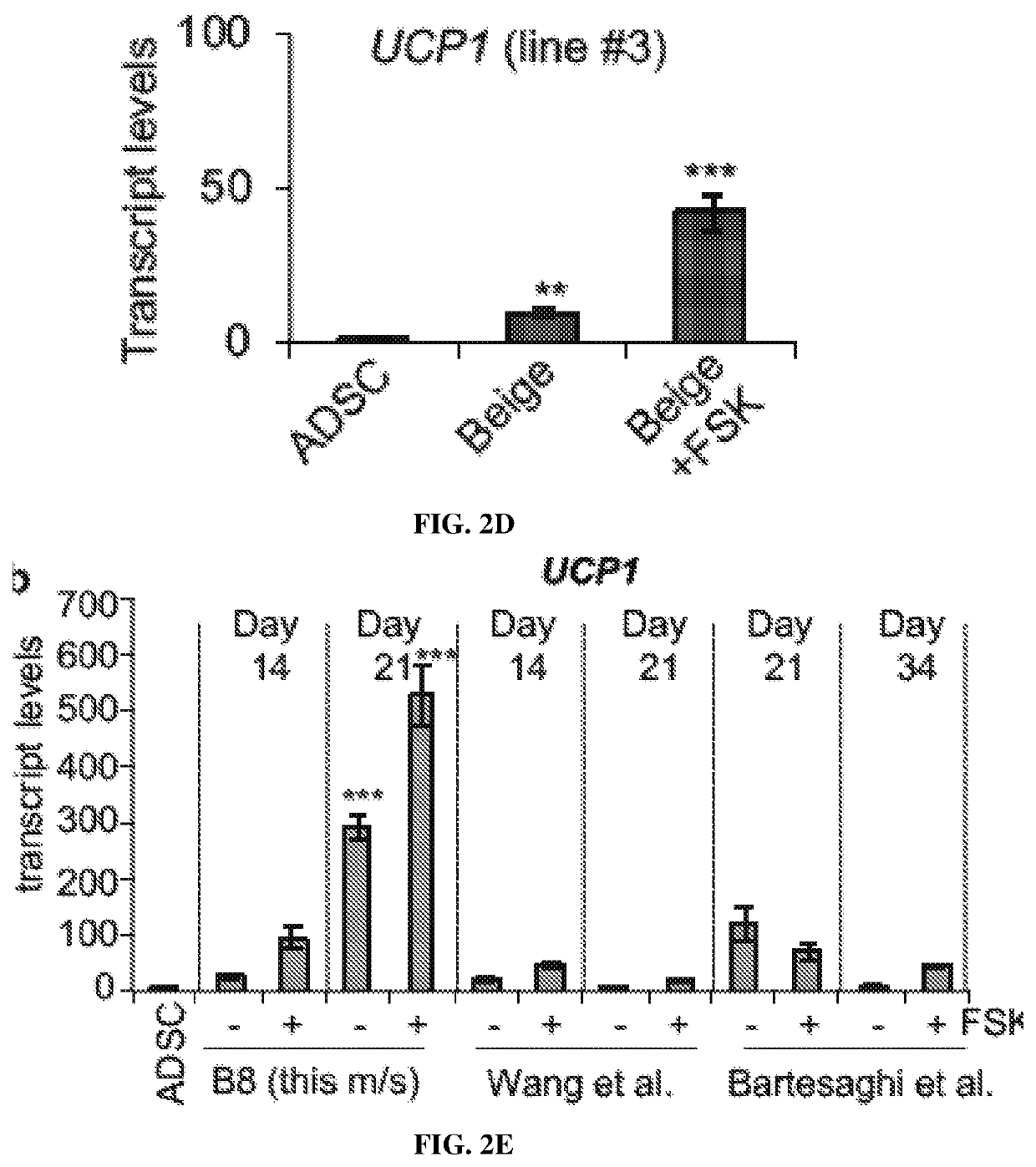Non-naturally occurring thermogenic adipocytes, methods of making, and methods of use thereof
a thermogenic adipocyte and non-natural technology, applied in the field of non-naturally occurring thermogenic adipocytes, methods of making, can solve the problems of unsuitable therapeutic development, unviable therapeutic development, unsuitable approach for therapeutic use, etc., to increase thermogenic activity, increase glucose uptake, and reduce weight gain
- Summary
- Abstract
- Description
- Claims
- Application Information
AI Technical Summary
Benefits of technology
Problems solved by technology
Method used
Image
Examples
example 1
iation and Molecular Characterization of GlucoCytes
[0180]Materials and Methods
[0181]Cell Culture and Differentiations
[0182]ADSCs (ThermoFisher, cat no: R7788115, Lot #: 1001001 and Lot #1001002; ATCC, ASC52telo, cat no: ATCC SCRC-4000) were grown in ADSC-growth medium comprising 10% fetal bovine serum (Atlanta Biologicals, S10250) in DMEM (Corning, 10013CV) with 1× Antibiotic-Antimycotic (Corning, 30-004-CI), 1×MEM non-essential amino acids (Corning, 25-025-CI), 1× Glutagro (Corning, 25-015-CI) and 1×BME (ThermoFisher, 21985023). Cells were seeded at a density of 5000 cell / cm2 and passaged at 80-90% confluency, approximately 5 days post-plating. To passage cells from a 100 mm cell culture plate, ADSCs were first washed with DPBS (Corning, 21031CV) and then incubated with 5 ml of Accutase (Innovative Cell Technologies, AT104) for 5 minutes at room temperature. Next, 5 ml of DPBS was added and cells were centrifuged at 1000 rpm (200×g) for 4 min in a swinging bucket centrifuge. Cells ...
example 2
t Uncoupled Respiration and Thermogenic Activity
[0217]Materials and Methods
[0219]To perform the assay, ADSCs were plated on XFe24 plates (Agilent) at 5000 cell / cm2 and grown to confluency. Cells were differentiated to GC or WA as described above. The XF Cell Mito Stress Test Kit (Seahorse Bioscience, 103015-100) was used to perform the assay and performed according to manufacturer instructions. Briefly, Oligomycin (2 μM), FCCP (2 μM), and rotenone / antimycin a (5 μM each) were used during the assay at indicated time points, following analysis based on their titration. One day before the assay, cells were stimulated with forskolin (20 μM) for 24 hours in freshly prepared XF assay medium (Seahorse Biosciences, 102353-100) containing 25 mM glucose, 1× Glutagro and 1 mM sodium pyruvate. At 1 hour prior to the assay, cells were washed 3 times in freshly prepared XF assay medium and the medium was given to the cells as they were placed in a non-CO2 incubator at 37° C. F...
example 3
[0230]Materials and Methods
[0231]Animals
[0232]NOD / SCID mice (NOD / ShiLtSz genetic background, Jackson Laboratory, stock no. 001303) were purchased and used to establish a breeding colony. Mice were housed in Tecniplast GM500 individually ventilated cages in a temperature controlled room with 12 hour light / 12 hour dark cycles. Only male mice were used for STZ animal studies and females were used in the indirect calorimetry assay, ages dependent on the assay described below.
[0233]Animal experiments were performed following IACUC guidelines at the University of Georgia accredited through AAALAC international, and in compliance with Public Health Service policy through NIH Office of Laboratory Animal Welfare and USDA Animal Welfare Act and Regulations.
[0234]Transplantations and Thermal Imaging
[0235]ADSCs or fully-differentiated ADSC-derived beige adipocytes were transplanted into hindlimb muscles (at 10 locations on both sides) of SCID mice. Approximately 2 m...
PUM
| Property | Measurement | Unit |
|---|---|---|
| concentration | aaaaa | aaaaa |
| concentration | aaaaa | aaaaa |
| concentration | aaaaa | aaaaa |
Abstract
Description
Claims
Application Information
 Login to View More
Login to View More - R&D
- Intellectual Property
- Life Sciences
- Materials
- Tech Scout
- Unparalleled Data Quality
- Higher Quality Content
- 60% Fewer Hallucinations
Browse by: Latest US Patents, China's latest patents, Technical Efficacy Thesaurus, Application Domain, Technology Topic, Popular Technical Reports.
© 2025 PatSnap. All rights reserved.Legal|Privacy policy|Modern Slavery Act Transparency Statement|Sitemap|About US| Contact US: help@patsnap.com



